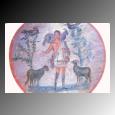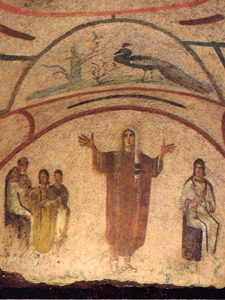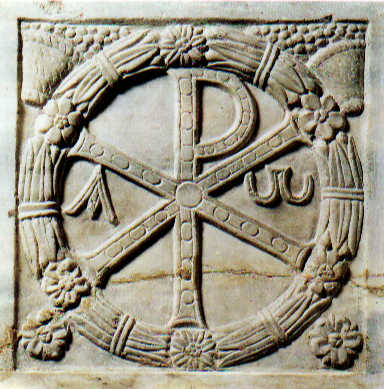|
|
 |
|
Enter into the underground... |
|
written
by calaroni / 09.08.2004 |
|
|
| |
Function |
| |
| |

|
|
| The Good Shepherd, a common symbol |
|
| |
|
| |

|
|
| The "Orante" or "Orans" |
| The Valata discussed earlier is a symbol of the Orante. Above the Orante is a Peacock, another symbol used in early Christian imagery, symbolizing immortality. It is said that a peacock's skin remains forever. |
| |
|
| |

|
|
| The Monogram of Christ |
| Look closely to see the Greek letters X (chi) and P (ro). |
| |
|
| |

|
|
| The fish continues to be a popular symbol of Christ even today |
|
| |
|
| |

|
|
| Ichthus |
|
| |
|
The catacombs of Rome are the ancient pagan, Christian, and Jewish underground cemeteries. Originally, Christians were buried alongside non-Chrstians in the catacombs. The Christian catacombs date from the second to the fifth centuries AD. At first, the catacombs were merely burial places; places where Christians could meet to perform funeral rites and celebrate the anniversaries of the martyrs and the dead. During the persecutions for the third century, Christians used the catacombs as places of momentary refuge for the celebration of the Eucharist. Although it has been suggested that the catacombs were secret hiding places for Christian worship, this is merely a myth. Despite the large rooms and chambers of the catacombs, Christians did not use them to escape the persecutions aboveground; instead, such rooms were used to hold meals for the dead, a ceremony performed by both Christians and non-Christians of the time. Michael White, a professor at the University of Texas, writes, “So, we have to imagine as part of their daily life, as part of their regular activity, Christians, just like their pagan neighbors, going down into the catacombs to hold memorial meals with dead members of their families.”
As the early Christians were continuously persecuted, they began the use of symbols in order to express their faith without openly drawing attention to themselves. These symbols appear on the walls of the catacombs and are carved upon the slabs that seal the tombs. These symbols were carved and painted upon the walls of the catacombs for all visiting Christians to see and recognize as a sign of faith. A symbol is a concrete sign or figure that stands for an idea or a spiritual reality, a visible sign of something invisible. The main symbols are the Good Shepherd, the “Orante” or “Orans”, the monogram of Christ, and the fish. The Good Shepherd is a young man with a lamb around his shoulders who represents Christ and a soul that he has saved. The “orante” is a praying figure with open arms that signifies a soul that lives in divine peace. The monogram of Christ is formed by the first two letters of the Greek word “Chistos” or Christ: X (chi) and P (ro). When this monogram was inscribed on tombstones, it meant that Christians were buried there. The fish, a widespread symbol of Christ, often contains the Greek letters IXTHYS (ichtus). Written vertically, the letters form an acrostic meaning Iesus Chirstos Theou Uios Soter, meaning Jesus Christ, Son of God, Savior.
Other symbols used in the catacombs include the dove and an olive branch, symbolizing a soul that has reached divine peace, and the phoenix, a mythical Arabian bird, which, according to ancient beliefs, arises from its ashes after a thousand years. The phoenix is the symbol of the resurrection of the bodies. Overall, the symbols, along with the frescos depicting scenes from the Old and New Testaments, “…form a miniature Gospel, a summary of the Christian faith.”
Although many of these symbols are seen as strictly Christian symbols today, they arose from pagan symbols that had existed in Rome before Christianity. What we call the Good Shepherd, for example, is a shepherd with a sheep over his shoulders that we tend to think symbolized the biblical stories of Jesus and the lost sheep. As written by Frontline’s Michael White: “…From Roman perspective, this is the virtue of philanthropy, of love of humanity, and it's one of the most important virtues of Roman civic and public life. The Christians seem to take it over very readily and apply it to the gospel virtues as well. In the case of the ‘orans’ figure..., this is the old pagan virtue of piety, of loyalty to the state, and so the person standing with eyes up cast toward heaven and hands in a gesture of appeal to the gods could have been seen by a pagan as a sign of loyalty to the state, loyalty to the old gods. To the Christians it becomes loyalty to the God of Jesus Christ.”
In learning about the symbols and art of early Christianity, it is important to view the larger picture rather than merely assume the Christians invented these symbols themselves. As with many things considered new and different, the art and symbolism within the Christian catacombs are merely adaptations of pagan symbols fit to the Christian faith.
|
| |
|
| |
|
|
 |
|





